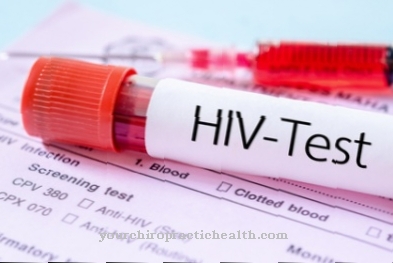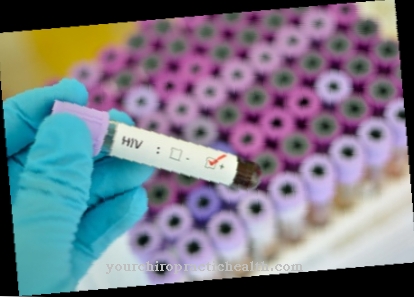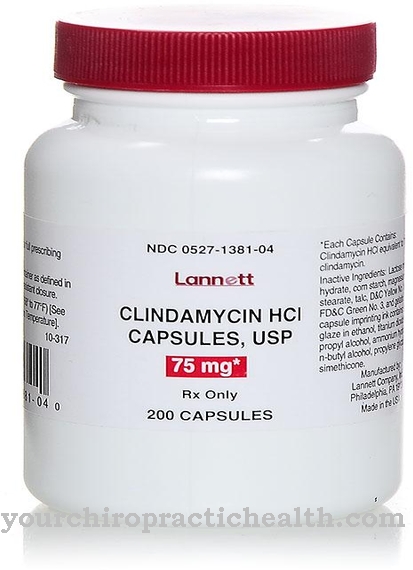At Anagrelide it is an active ingredient from the group of antineoplastics. The drug is available in Germany in the form of hard capsules under the trade name Xagrid® and as a generic drug. Anagrelide is used to treat essential thrombocythemia.
What is anagrelide?

Anagrelide is used to treat essential thrombocytoses, which are characterized by an increased number of platelets in the blood that are formed in the bone marrow. Anagrelide is also recommended as a second-line therapy for so-called risk patients who did not tolerate the previous treatment well or did not respond well enough to it.
The drug anagrelide was approved by the European Medicines Agency - or EMEA for short - at the end of 2004 as a secondary therapy for this group of patients who are intolerant or who do not respond to the previous primary therapy. Anagrelide was originally developed as a platelet aggregation inhibitor. At the same time, the active ingredient also inhibits the maturation of megakaryocytes.
Pharmacological effect
The pharmacological effect of anagrelide on the body and organs has not yet been clarified. Initial research led to the assumption that the administration of anagrelide induces an inhibition of platelet aggregation. This is to be understood as the containment effect on the clumping of blood platelets, which promotes the formation of blood clots - thrombi.
However, further studies showed that anagrelide did not have any anti-platelet effects. However, it very quickly reduces the number of platelets in the blood. Why is unknown. What is certain, however, is that anagrelide works well as an inhibitor of type 3 cAMP phosphodiesterase. So this is probably the answer to how anagrelin works. The active ingredient appears to be sheathed into the post-mitotic phase in the development of megakaryocytes, thus influencing their maturation and size as well as the number of chromosomes.
The prevention of phosphodiesterase-III increases the levels of cyclic adenosine monophosphate (cAMP) in the blood platelets. High-dose anagrelide also inhibits this aggregation. Anagrelide has a platelet-selective effect and therefore does not affect the formation of white and red blood cells.
Clinical studies of over 4,000 patients with myeloproliferative disorders showed that they responded to therapy with anagrelide within 4 to 12 weeks.
Medical application & use
Anagrelide is used to treat thrombocytosis. Patients with thrombocytosis suffer from myeloproliferative diseases such as
- essential thrombocythemia (ET)
- Polycythemia vera (PV)
- chronic myeloid leukemia (CML)
- Osteomyelofibrosis (OMF)
Thrombocytosis results in an increased number of platelets formed in the bone marrow and released into the bloodstream. These blood platelets, also known as thrombocytes, in excess easily lead to hemorrhagic and thrombotic diseases such as transient ischemic attacks (TIA), strokes or thrombosis of smaller blood vessels.
In rare cases, acute leukemia can develop. When a thrombocytosis is diagnosed, many of those affected, mostly over 50 years of age, do not yet have any subjective symptoms. Nevertheless, due to the existing risks, countermeasures should be taken in good time with medication.
The recommended starting dose for anagrelide is 1 mg per day, divided into two doses. The capsules can be taken with a meal or on an empty stomach. After one week, the individual dose is set, whereby the maximum single dose should be 2.5 mg. After stopping anagrelide, platelets return to their baseline levels in 10 to 14 days.
Laboratory tests for the liver and kidneys must be carried out closely during therapy with anagrelide.
Risks & side effects
When taking anagrelide you may experience undesirable side effects such as:
- stomach pain
- nausea
- flatulence
- diarrhea
- dizziness
- a headache
- Palpitations
- Tachycardia
- weakness
- Edema
Serious cardiovascular side effects have been observed when anagrelide was taken on the market. These also affected patients with no suspicion of heart disease or normal findings in cardiovascular examinations carried out before starting therapy with anagrelide. Therefore, anagrelide is only an option as a second-line therapy in high-risk patients.
Anagrelide is contraindicated in cases of increased sensitivity to the active ingredient, moderate to severe liver damage and renal insufficiency. Pregnant and breastfeeding women are also excluded from anagrelide therapy.
Anagrelide works interactively with the following drugs:
- Antiplatelet drugs
- Phosphodiesterase inhibitors
- Acetylsalicylic acid
- Sucralfate



























